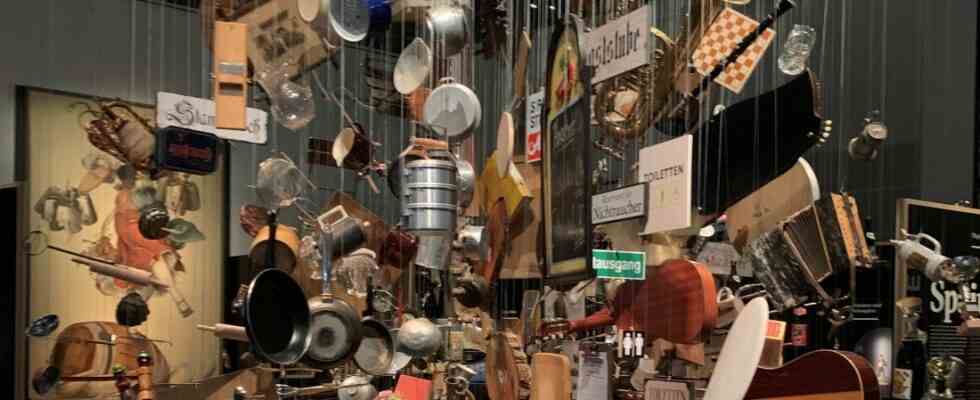Immediately after entering the new exhibition “Tavern death? Tavern life!” In the House of Bavarian History in Regensburg, two sensations catch your eye. And they directly express the inner turmoil that characterizes the theme of this show. The exhibition explores the question of how the currently rampant dying out of taverns could have come about, even though the Bavarian tavern culture and its proverbial cosiness are recognized worldwide and are still considered to be extremely attractive. This dichotomy is illustrated with a production that has never been seen before. The experienced exhibition technician Friedrich Pürstlinger tried to depict the status quo with a kind of explosion of the Bavarian tavern, and he succeeded impressively. This explosion fills the center of the hall, with more than 400 items from dining rooms and kitchens of abandoned taverns floating in space and staged with the help of lighting effects and floor projection. The message is as drastic as the work of art is spectacular.
The peppy Coletta was sort of an early IT girl
Immediately behind it, the five by three meter monumental painting of the Schützenlisl on the wall, which the then young painter Friedrich August von Kaulbach painted in 1881, is unmissable. He used the beer girl Coletta Möritz, who worked at the Munich Sterneckerbräu, as a model, who had turned the good Kaulbach’s head so much that he made a portrait drawing on the spot, which later served as a model for the facade painting. In this way, the spirited Coletta rose to become a kind of early IT girl and an advertising icon for the Bavarian beer industry. Even if her happy face hides the fact that being a waitress was one of the hardest jobs of all back then. It is unimaginable what these women had to do and endure on 16-hour days. As a loan for the Bavaria exhibition, the colossal painting left the premises of the Munich Hauptschützengesellschaft for the first time in 130 years.
Is the Bavarian inn really a case for the museum? Richard Loibl, director of the House of Bavarian History, and project manager Michael Nadler asked this question during a press tour of the room. In fact, one must not delude oneself. The Corona crisis has again accelerated the death of taverns, but it is also true that this process is taking much longer. The taverns began to weaken more than a hundred years ago, after bottled beer had started its triumphal march and the street taverns became superfluous. From then on, further difficulties regularly arose for the economies. The exhibition cites many examples, such as a smoking ban, lower alcohol consumption, staff shortages, excessive bureaucracy and, last but not least, the efforts of clubs to abandon their inns and build their own homes.
In 1881, Friedrich August von Kaulbach painted the beer girl Coletta Möritz as Schützenlisl.
(Photo: Philipp Mansmann/House of Bavarian History)
Munich beer pub around 1890, painted by Eduard von Grützner.
(Photo: Maximilian Brückner/House of Bavarian History)
Souvenir from the 1933 Chicago World’s Fair.
(Photo: Uwe Moosburger/House of Bavarian History)
The hardships are expressed quite vividly in a half-hour film documentation that is shown to accompany the exhibition. The author Michael Bauer visited old traditional inns that closed their doors even before the Corona lockdowns. Many (former) innkeepers had to close because the business was no longer profitable or no successor could be found. Their parlors not only give an idea of the earlier heydays, but also of the loss of culture that accompanied their decline.
But the exhibition and the film also give hope, because it cannot be overlooked that some inns are still buzzing. With kettle meat, art exhibitions and above all with a skilful marketing of their specialties, they defy the dying out of the inn. In the “oldest inn in the world”, the Röhrl in Eilsbrunn near Regensburg, the regional delicacies still come from the hundred-year-old stove. Elsewhere, committed citizens save once almost majestic inns, such as the “Post” in Triftern near Pfarrkirchen, from decay and fill them with new life.
Munich children, intoxicated, drawing from 1903 from Simplicissimus.
(Photo: Hans scratches)
Politics and tavern: “The dangers of the Munich Bräukeller” is the title of this drawing, on which Eisner (left) and Hitler are shown.
(Photo: Hans scratches)
Many are no longer aware that the Bavarian pub culture rode a wave of success worldwide a hundred years ago. This was thanks to the local breweries, which acquired international renown with entrepreneurial skills at the world exhibitions. And yet this is only a small excerpt from the potpourri of tavern life. Everything has always mixed up there, the good and the bad, the hard everyday life of the waitresses and the cosiness of the dignitaries, culinary delicacies and excessive alcohol consumption. And last but not least, the tavern was always a place where politics was made. That is why the exhibition also shows oppressive testimonies that document, for example, the hijacking of the inns and halls by the National Socialists.
Not only around 600 original exhibits, but also hands-on stations bring visitors closer to the varieties of hospitality. And if it’s just a matter of using VR glasses to test whether you’d be able to put the key in the front door after drinking a lot of beer. More important, however, are the recipes for how the traditional taverns can remain sustainable, which are presented by tavern experts like Gerhard Polt with all seriousness and humor and thus make the philosophical scope of this culture even more clear.
Immediately after the opening on Friday, the Bayern exhibition in Regensburg will be accompanied by an adventure weekend. On Saturday and Sunday there is free entry to all exhibitions from 9 a.m. to 9 p.m. The exhibition “Inns dying out? Inns living!” runs until December 11th. Information about the program at www.hdbg.de/wirtshausleben.

